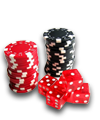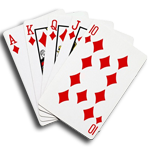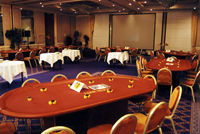 Development of events
Development of events 
A - Fixed formula
The Master of Ceremonies will name each table. For example; Marseille table, Swiss, Aliens...Losers or Stallions! Or else names associated with the company, the business or the nature of client.
The participants will draw their seats on the various tables. Once everyone is seated the MC will tell the dealers to commence the games.
B - Open formula
Participants sit where they wish and the MC will declare the games open.
 Beginning of the Games
Beginning of the Games 

A championship takes place during one or two sessions depending on the type of structure ( see tournament structure), the timing, whether it is connected with a cocktail event....The management of the timing of the sessions, raising the blinds, coordination with the traiteur can , if necessary, be dealt with by the MC.
Type of structure prefered...this has the merit of assisting those who have either never played or have played very little poker, and to break up the event with breaks: for cocktails, between dishes, cigarette breaks....
A - Session with fixed blinds/introduction
A limited session: fixed bets, every player starts with the same buy-in, enough to participate for the whole event, this will permit the enjoyment of the spirit and philosophy of the game rather than the strategy and position. Focusing on the rules of the game and not on the bets, bluff, attack....the essence is the learning!
Why is this session limited?
- Not all are seasoned players, therefore this preparation permits them to become so .
- To permit novices to play equally during the two part s of the session. And also to beat the so-called "connaisseurs".
- To profit financially and artistically from the event. Imagine, if you will, the organizer who sees his guests go "all in" (bet everything on one hand), and a quarter or a third disappear within the first few minutes.
B - Session of no limit/selection of the best
The second half as no limit: unlimited bets.
The player can go "all-in", bet everything on one hand.
"Sit and Go", elimination direct and by table. A flexible and fast structure.
Example: 100 participants, 10 tables of 10 players, the best from each table at the end of the first round qualifies for the final "up", consisting of 10 players. These will be eliminated one by one to designate the winner or the first three.
The other 90 participants will play a round on 9 tables of 10, which will qualify the best nine to participate in the final "down" of losers.

C - Session of unlimited bets
Competition between the best of the second round and the final "up".
Competition between the losers of the second round until the final "down".
 Distribution of trophies/prizes
Distribution of trophies/prizes 
Cups, other trophies, fun prizes, official bulletin for the winner...




